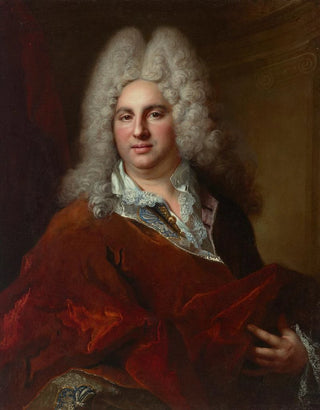Art print | Portrait of a gentleman - Nicolas de Largillière


View from behind

Frame (optional)
In the fascinating world of 18th-century painting, the "Art print of a gentleman" by Nicolas de Largillière stands out for its elegance and refinement. This iconic work, which captures the very essence of the classical portrait, immerses us in a world where social status and personal identity are intertwined with unparalleled technical mastery. Through this representation, Largillière does not merely freeze an image, but evokes an atmosphere, a personality, and an era. This painting, a true mirror of a society in full transformation, invites the viewer to reflect on the history contained within each brushstroke.
Style and uniqueness of the work
Largillière's style is characterized by a radiant luminosity and meticulous attention to detail, which give his portraits a rare psychological depth. In the "Art print of a gentleman," the interplay of light and shadow reveals the subject's features with striking delicacy. The artist excels in depicting textures, whether it is the rich fabric of the jacket or the delicate skin of the face; each element is treated with precision that demonstrates his talent. The colors, both vivid and harmonious, create a warm atmosphere, while the posture of the gentleman, both confident and contemplative, suggests a complex personality. This painting, far from being a simple representation, becomes an invitation to explore the nuances of human nature.
The artist and his influence
Nicolas de Largillière, an emblematic figure of French painting, established himself as one of the great masters of portraiture in the 18th century. Trained in a rich artistic context, he was influenced by the great names of his time, while developing a style that is uniquely his own. His innovative approach, blending realism and idealization, marked a generation of artists and contributed to the evolution of the portrait as a genre. Largillière was able to capture the spirit of his era by incorporating elements of daily life and paying homage to the diversity of personalities he portrayed. His work continues to inspire and fascinate, testifying to the timelessness of his art.

Matte finish

View from behind

Frame (optional)
In the fascinating world of 18th-century painting, the "Art print of a gentleman" by Nicolas de Largillière stands out for its elegance and refinement. This iconic work, which captures the very essence of the classical portrait, immerses us in a world where social status and personal identity are intertwined with unparalleled technical mastery. Through this representation, Largillière does not merely freeze an image, but evokes an atmosphere, a personality, and an era. This painting, a true mirror of a society in full transformation, invites the viewer to reflect on the history contained within each brushstroke.
Style and uniqueness of the work
Largillière's style is characterized by a radiant luminosity and meticulous attention to detail, which give his portraits a rare psychological depth. In the "Art print of a gentleman," the interplay of light and shadow reveals the subject's features with striking delicacy. The artist excels in depicting textures, whether it is the rich fabric of the jacket or the delicate skin of the face; each element is treated with precision that demonstrates his talent. The colors, both vivid and harmonious, create a warm atmosphere, while the posture of the gentleman, both confident and contemplative, suggests a complex personality. This painting, far from being a simple representation, becomes an invitation to explore the nuances of human nature.
The artist and his influence
Nicolas de Largillière, an emblematic figure of French painting, established himself as one of the great masters of portraiture in the 18th century. Trained in a rich artistic context, he was influenced by the great names of his time, while developing a style that is uniquely his own. His innovative approach, blending realism and idealization, marked a generation of artists and contributed to the evolution of the portrait as a genre. Largillière was able to capture the spirit of his era by incorporating elements of daily life and paying homage to the diversity of personalities he portrayed. His work continues to inspire and fascinate, testifying to the timelessness of his art.






